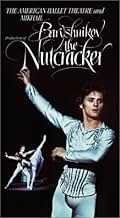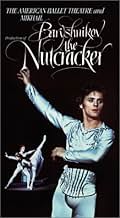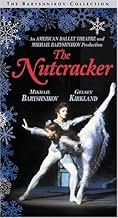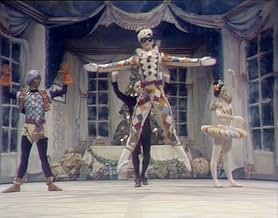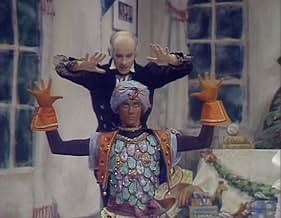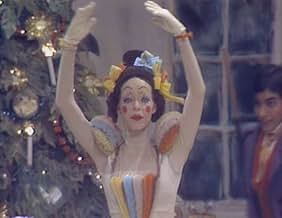Aggiungi una trama nella tua linguaThe television adaptation of the Baryshnikov production.The television adaptation of the Baryshnikov production.The television adaptation of the Baryshnikov production.
- Regia
- Sceneggiatura
- Star
- Candidato a 2 Primetime Emmy
- 2 candidature totali
Recensioni in evidenza
If you are only interested in ballet and not storyline or sets or costumes, then watch this version. Otherwise, it looks like a high-school production with crudely painted backdrops and lackluster costumes. There is no narration and you can't tell there is a story line, just people dancing around on a stage. Drosselmyer is an expressionless drone. The Spanish Hot Chocolate Performers are indistinguishable from the Arabian Coffee Performers who are indistinguishable from the Chinese Tea Performers who are indistinguishable from the Russian Candy Cane Performers who are indistinguishable from the Danish Marzipan Shepherdess Performers. For a great visual performance of this ballet, see Nutcracker: The Motion Picture.
The Nutcracker (1977) ballet starred then 29 year old Michail Baryshnikov who, in 1977, could out do Michael Jordan and Disney's Peter Pan (1952) in the "flying effortlessly" department. Baryshikov and his 1977 dance partner and muse, Gelsey Kirkland, defied gravity when this classic ballet was produced on monster, empty, no-audience TV sound stages in Toronto, Ontario, Canada. The camera didn't lie. Those two really did what viewers can still watch and admire, can still gasp at while smiling in delighted amazement.
Ballet is all about human beings who can fly ......... defy gravity when all is said and done. The best ballet dancers (Baryshikov and Kirkland in the 1977 version of The Nutcracker ballet) do it better than others ...... fly higher, longer, and smoother.
Not many ballet dancers (or people generally) can fly. That was true of the National Ballet Company of Canada supporting dancers who fill out the parts of this show when Baryshikov and Kirkland are not on stage, busy mesmerizing viewers.
Baryshikov and his management staff produced The Nutcracker in Canada on the cheap for TV broadcast. They went over the USA border to Canada where union problems and costs which encumber producers in USA ballet cities (New York City and Los Angeles) were not present, and where a very large, detailed, and gaudy background stage setting could be built on one of Toronto Canada's then huge sound stages.
The result was that Baryshinikov and Kirkland's amazing flying abilities were provided with a much more spacious venue than normal stages in the USA ever offer. The setting in the Nutcracker (1977) was spacious and wonderfully decorated, and the very space and stage decoration of this show became co-stars with the amazing flying dance abilities of the two major stars.
Michail Baryshikov was 29 years old in 1977, and was at the height of his airborne talents.
Baryshikov's choreography in the Arabian dance, Russian dance, Chinese dance segments of the presented ballet is absolutely unparalleled.
The action slows down when Baryshikov and Kirkland are not dancing.
National Ballet Of Canada dancers (probably not paid or rehearsed much for this thrifty dance show) perform for Michail Baryshikov and Gelsey Kirkland.
They are adequate. They are not brilliant or memorable. Not at all as good as the two main stars.
These secondary National Ballet Company Of Canada dancers perform by turns a Spanish dance, an Arabian dance, a Russian dance, a Chinese dance, each performed by a male and female duo. These secondary dancers are not gifted with the sort of precision and therefore the grace of the star dancers, and the contrast is noticeable.
Not to worry, not to gripe.
The chance to see Michail Baryshikov and Gelsey Kirkland dance (fly effortlessly) at the height of their dance careers and abilities is worth the price of admission and the time invested in watching their incredible performances. Never mind about less than ideal "fill in" parts of the show unavoidable because material resources (money!) was limited, and because spectacular dance talent is hard to find, manage, recruit. It's never cheap when it is presented, and the quest for "cheap" explains the shortcomings of this show.
"It's a waste of time to worry over things that they have not! Be thankful for ....................... the things they've got!" (There Is Nothing Like A Dame song from the broadway stage musical 1949 classic, South Pacific). -------------------------- Written by Tex Allen, SAG/AFTRA actor and movie historian. More about Tex Allen and his 119 IMDb movie reviews (as of December 26, 2017) by visiting IMDb.Com and using Tex Allen as search terms. --------------------------------------
Ballet is all about human beings who can fly ......... defy gravity when all is said and done. The best ballet dancers (Baryshikov and Kirkland in the 1977 version of The Nutcracker ballet) do it better than others ...... fly higher, longer, and smoother.
Not many ballet dancers (or people generally) can fly. That was true of the National Ballet Company of Canada supporting dancers who fill out the parts of this show when Baryshikov and Kirkland are not on stage, busy mesmerizing viewers.
Baryshikov and his management staff produced The Nutcracker in Canada on the cheap for TV broadcast. They went over the USA border to Canada where union problems and costs which encumber producers in USA ballet cities (New York City and Los Angeles) were not present, and where a very large, detailed, and gaudy background stage setting could be built on one of Toronto Canada's then huge sound stages.
The result was that Baryshinikov and Kirkland's amazing flying abilities were provided with a much more spacious venue than normal stages in the USA ever offer. The setting in the Nutcracker (1977) was spacious and wonderfully decorated, and the very space and stage decoration of this show became co-stars with the amazing flying dance abilities of the two major stars.
Michail Baryshikov was 29 years old in 1977, and was at the height of his airborne talents.
Baryshikov's choreography in the Arabian dance, Russian dance, Chinese dance segments of the presented ballet is absolutely unparalleled.
The action slows down when Baryshikov and Kirkland are not dancing.
National Ballet Of Canada dancers (probably not paid or rehearsed much for this thrifty dance show) perform for Michail Baryshikov and Gelsey Kirkland.
They are adequate. They are not brilliant or memorable. Not at all as good as the two main stars.
These secondary National Ballet Company Of Canada dancers perform by turns a Spanish dance, an Arabian dance, a Russian dance, a Chinese dance, each performed by a male and female duo. These secondary dancers are not gifted with the sort of precision and therefore the grace of the star dancers, and the contrast is noticeable.
Not to worry, not to gripe.
The chance to see Michail Baryshikov and Gelsey Kirkland dance (fly effortlessly) at the height of their dance careers and abilities is worth the price of admission and the time invested in watching their incredible performances. Never mind about less than ideal "fill in" parts of the show unavoidable because material resources (money!) was limited, and because spectacular dance talent is hard to find, manage, recruit. It's never cheap when it is presented, and the quest for "cheap" explains the shortcomings of this show.
"It's a waste of time to worry over things that they have not! Be thankful for ....................... the things they've got!" (There Is Nothing Like A Dame song from the broadway stage musical 1949 classic, South Pacific). -------------------------- Written by Tex Allen, SAG/AFTRA actor and movie historian. More about Tex Allen and his 119 IMDb movie reviews (as of December 26, 2017) by visiting IMDb.Com and using Tex Allen as search terms. --------------------------------------
They rarely show this on TV anymore, but it is by far the best of them all! Misha is at the height of his airborne talents. and his choreography in the "arabian dance, Russian dance, Chinese dance, etc..." is absolutely unparalleled. it's become an obsession to see it every year at this time. i suppose they never air it on TV anymore is because it's just the best one there is out there and they want you to spend the money and rent it or buy it. but if you're a ballet fan, i'd say buy it. and if you're not a ballet fan... set your DVD and JUST WATCH THE SEQUENCE where the duo's of internationally ethnic dancers perform for Misha and Kelsey. there's a Spanish dance, an arabian dance, a Russian dance, a Chinese dance, a Russian dance and a milliton dance. each performed by a male and female duo.
While other film and video productions of the Tchiakovsky classic emphasize pageantry, amazing sets, and holiday warmth, the American Ballet Theater's `Nutcracker' concentrates on strong dancing and intricate choreography. There is consequently much to adore in this production. Gelsey Kirkland, at the prime of her career, and before her drug addiction and battle with anorexia tragically destroyed her dancing talent, plays Clara as a young girl who matures over the course of the ballet. As such, Baryshnikov's version is less a story of a young girl's Christmas dream, and more a coming-of-age tale.
The party scene of `The Nutcracker' is usually a showcase for the children's classes of a ballet company. The Balanchine version, for example, does not really employ any serious dancing until the Waltz of the Snowflakes; most of the first act features children mulling about with their presents. Baryshnikov chose instead to concentrate on adult dancers, turning the Drosselmayer gift sequences in particular into amazingly intricate, well-danced pieces. The Moorish dance stands out as one of the finest, most exciting dances ever to be caught on film.
Unfortunately, this production does have a few weaknesses. The dancers reportedly complained that the television set where it was filmed was too cramped, and that the soundtrack was too slow. Indeed, the sound throughout is awful; there are many more vibrant recordings of the music that could have been used. These dancers are professionals used to working with a live orchestra, and they seem confined by the canned music. The sets are unspectacular and washed-out, making this version perhaps the least exciting for young children; both the NYC Ballet and the Sendak version are more visually stimulating.
Still, for fans of serious dance, this version must be seen. It is still a thrill to watch Baryshnikov and Kirkland perform.
The party scene of `The Nutcracker' is usually a showcase for the children's classes of a ballet company. The Balanchine version, for example, does not really employ any serious dancing until the Waltz of the Snowflakes; most of the first act features children mulling about with their presents. Baryshnikov chose instead to concentrate on adult dancers, turning the Drosselmayer gift sequences in particular into amazingly intricate, well-danced pieces. The Moorish dance stands out as one of the finest, most exciting dances ever to be caught on film.
Unfortunately, this production does have a few weaknesses. The dancers reportedly complained that the television set where it was filmed was too cramped, and that the soundtrack was too slow. Indeed, the sound throughout is awful; there are many more vibrant recordings of the music that could have been used. These dancers are professionals used to working with a live orchestra, and they seem confined by the canned music. The sets are unspectacular and washed-out, making this version perhaps the least exciting for young children; both the NYC Ballet and the Sendak version are more visually stimulating.
Still, for fans of serious dance, this version must be seen. It is still a thrill to watch Baryshnikov and Kirkland perform.
As far as I'm concerned you can hardly see 'The Nutcracker' too many times. Here's your chance to see a couple of the greatest dancers of their time, Mikhail Baryshnikov and camera-shy Gelsey Kirkland, in one of the all-time classics. Plus the music of Tchaikovsky is glorious from beginning to end.
Lo sapevi?
- QuizThis was originally a stage production, but rather than taping or filming it in a theatre with a live audience, Baryshnikov chose to have the sets enlarged and taped it in a television studio with no audience.
- Curiosità sui creditiMarcos Paredes, who dances both the roles of The Mouse King and the drunken guest at the Christmas party, does not receive any screen credit for playing the drunken guest.
- Versioni alternativeThe original CBS broadcast presentation of this production featured more narration than the later television broadcasts of it. In the original 1977 version, as the mice appear in their tuxedos, the narrator explains that, in Clara's imagination, they represent the adults at the Christmas party, and in Act II, just before the series of dances at the Kingdom of Sweets, the narrator mentions that Clara "must touch each couple to bring them to life". In the PBS version, all mention of the mice representing the adults was removed, but the narrator still commented that Clara had to bring the couples to life. On the current DVD, and on all PBS telecasts now, all narration stops after the opening scene. The narration was removed without having to cut any of the music or the dancing; both have always remained intact in all of the versions of this "Nutcracker".
- ConnessioniEdited into Breakfast with the Arts: The Nutcracker (1997)
- Colonne sonoreThe Nutcracker
(ballet)
Music by Pyotr Ilyich Tchaikovsky
Played by the National Philharmonic Orchestra, conducted by Kenneth Schermerhorn, with the boys of the Desborough School Chorus, conducted by Roger Durston
I più visti
Accedi per valutare e creare un elenco di titoli salvati per ottenere consigli personalizzati
Dettagli
- Data di uscita
- Paese di origine
- Lingua
- Celebre anche come
- Baryshnikov's Nutcracker
- Luoghi delle riprese
- Toronto, Ontario, Canada(Studio)
- Azienda produttrice
- Vedi altri crediti dell’azienda su IMDbPro
Contribuisci a questa pagina
Suggerisci una modifica o aggiungi i contenuti mancanti

